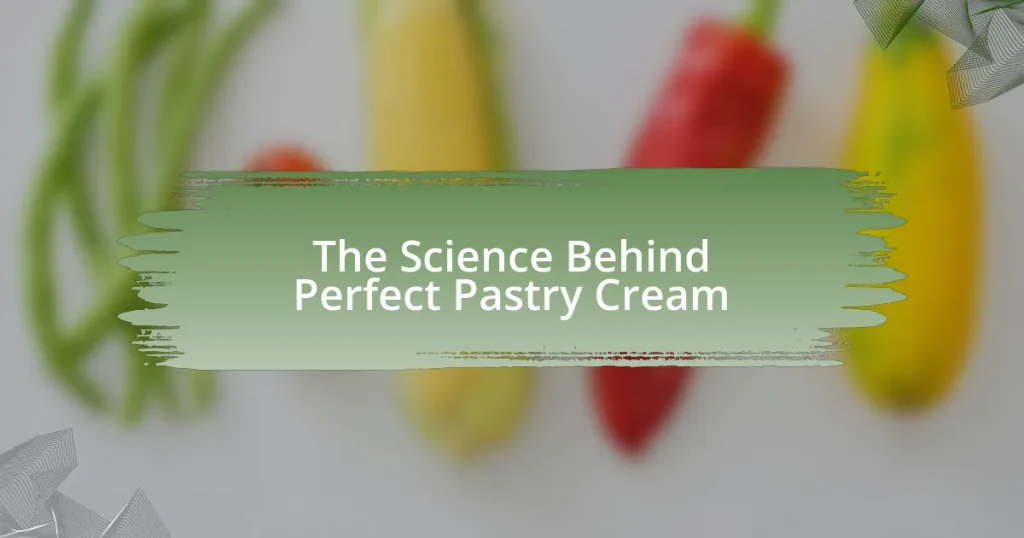The main entity of the article is pastry cream, a rich custard made from milk, sugar, egg yolks, and starch, essential for various desserts. The article delves into the scientific principles behind achieving perfect pastry cream, emphasizing the interactions of ingredients and the importance of precise cooking techniques. Key topics include the role of temperature and timing in thickening, the characteristics of ideal pastry cream, and methods to prevent common issues such as curdling and lumps. Additionally, it outlines best practices for storing and incorporating pastry cream into desserts, ensuring optimal flavor and texture.

What is the Science Behind Perfect Pastry Cream?
The science behind perfect pastry cream involves the precise interaction of ingredients, primarily milk, sugar, eggs, and starch, which create a stable emulsion and thickened texture. When heated, the starch granules swell and absorb moisture, thickening the mixture as it cools, while the proteins in the eggs coagulate, providing structure and richness. This process is critical because it ensures the pastry cream achieves the desired consistency and flavor. The ideal temperature for cooking pastry cream is around 85°C (185°F), where the starch gelatinizes effectively without curdling the eggs, resulting in a smooth and creamy texture.
How is pastry cream defined in culinary terms?
Pastry cream, in culinary terms, is a rich custard made from milk, sugar, egg yolks, and cornstarch, which is cooked until thickened. This mixture serves as a versatile filling for various desserts, such as éclairs, tarts, and cakes. The combination of egg yolks and cornstarch provides both flavor and stability, allowing the cream to hold its shape when used in pastries.
What are the key characteristics of perfect pastry cream?
Perfect pastry cream is characterized by its smooth texture, rich flavor, and stable consistency. The smooth texture results from thorough cooking and whisking, which prevents lumps and ensures a velvety finish. A rich flavor is achieved through the use of high-quality ingredients, such as fresh eggs and vanilla, which enhance the cream’s taste profile. Stability is crucial, as perfect pastry cream should hold its shape without separating or becoming watery, often achieved by incorporating cornstarch or flour as thickening agents. These characteristics are essential for the cream to function effectively in various desserts, providing both taste and structural integrity.
Why is pastry cream considered a fundamental component in desserts?
Pastry cream is considered a fundamental component in desserts because it serves as a versatile filling and base for various confections. This creamy custard, made from milk, sugar, eggs, and starch, provides a rich texture and flavor that enhances the overall dessert experience. Its ability to stabilize and hold shape makes it ideal for pastries, tarts, and cakes, ensuring structural integrity while adding moisture and taste. Additionally, pastry cream can be flavored in numerous ways, allowing for creativity and customization in dessert preparation, which is essential in both classic and modern pastry techniques.
What are the essential ingredients in pastry cream?
The essential ingredients in pastry cream are milk, sugar, egg yolks, cornstarch, and butter. Milk serves as the base, providing creaminess, while sugar adds sweetness. Egg yolks contribute richness and act as a thickening agent, and cornstarch enhances the cream’s stability and texture. Finally, butter is incorporated for a smooth finish and added flavor. These ingredients work together to create a velvety and flavorful pastry cream, commonly used in various desserts.
How do eggs contribute to the texture of pastry cream?
Eggs contribute to the texture of pastry cream by providing emulsification, thickening, and stabilization. The proteins in eggs coagulate when heated, which thickens the cream and gives it a smooth, creamy texture. Additionally, the lecithin in egg yolks acts as an emulsifier, helping to blend fat and water, resulting in a stable mixture that enhances the cream’s overall consistency. This combination of coagulation and emulsification is essential for achieving the desired velvety texture in pastry cream.
What role does sugar play in the flavor and consistency of pastry cream?
Sugar enhances the flavor and consistency of pastry cream by providing sweetness and contributing to its smooth texture. The sweetness from sugar balances the richness of the cream and eggs, creating a harmonious flavor profile. Additionally, sugar plays a crucial role in the thickening process; it interacts with the proteins in the eggs and stabilizes the mixture, resulting in a creamy and velvety consistency. This interaction is essential for achieving the desired texture, as sugar helps to prevent the formation of a grainy texture by ensuring even distribution of moisture and fat throughout the cream.
Why is milk or cream important in the preparation of pastry cream?
Milk or cream is essential in the preparation of pastry cream because it provides the necessary fat and liquid content that contributes to the cream’s smooth texture and rich flavor. The fat from milk or cream helps to emulsify the mixture, allowing for a stable and creamy consistency, while the liquid aids in the cooking process, ensuring that the starches in the mixture hydrate properly. This combination results in a velvety pastry cream that can be used in various desserts.
What techniques are used to achieve the perfect pastry cream?
To achieve the perfect pastry cream, techniques such as tempering eggs, using cornstarch as a thickening agent, and incorporating butter for richness are essential. Tempering eggs involves gradually adding hot milk to beaten eggs to prevent curdling, ensuring a smooth texture. Cornstarch is mixed with sugar and a portion of the milk before heating, which helps stabilize the cream and achieve the desired thickness. Finally, adding butter at the end of cooking enriches the flavor and creates a silky finish. These methods are supported by culinary science, which emphasizes the importance of temperature control and ingredient interaction in creating a stable and flavorful pastry cream.
How does the cooking process affect the final texture of pastry cream?
The cooking process significantly influences the final texture of pastry cream by determining the thickening and stabilization of the mixture. During cooking, the heat activates the starches and proteins in the egg yolks, which gelatinize and coagulate, respectively, leading to a creamy and smooth consistency. If the mixture is cooked too long or at too high a temperature, it can curdle or become grainy due to overcooked proteins. Conversely, insufficient cooking results in a runny texture because the starches do not fully hydrate and thicken the cream. Therefore, precise temperature control and cooking time are essential for achieving the desired velvety texture in pastry cream.
What are the common methods for thickening pastry cream?
Common methods for thickening pastry cream include using cornstarch, flour, or egg yolks. Cornstarch is often mixed with sugar and then combined with milk to create a slurry, which thickens when heated. Flour can be used similarly, but it requires cooking longer to eliminate its raw taste. Egg yolks, when tempered and added to the mixture, also contribute to thickening due to their emulsifying properties. These methods are widely recognized in culinary practices, ensuring a stable and creamy texture in pastry cream.

How do temperature and timing influence pastry cream?
Temperature and timing significantly influence the texture and stability of pastry cream. When heated, the proteins in eggs coagulate, thickening the mixture; if the temperature is too high, it can lead to curdling, while too low a temperature results in an insufficiently thickened cream. Timing is crucial as well; allowing the cream to cook for the right duration ensures proper thickening and prevents the formation of a grainy texture. For instance, cooking pastry cream to a temperature of around 85°C (185°F) for a few minutes allows for optimal starch gelatinization, which is essential for achieving the desired consistency.
What is the ideal temperature for cooking pastry cream?
The ideal temperature for cooking pastry cream is between 180°F to 190°F (82°C to 88°C). At this temperature range, the starches in the mixture gelatinize, thickening the cream effectively while ensuring that the eggs are cooked properly to avoid any raw taste. This temperature is crucial for achieving the desired consistency and stability in pastry cream, as it allows for the proper emulsification of fats and liquids, resulting in a smooth and creamy texture.
How does temperature affect the coagulation of eggs in pastry cream?
Temperature significantly influences the coagulation of eggs in pastry cream by determining the rate at which proteins denature and form a gel-like structure. At temperatures around 140°F (60°C), egg proteins begin to coagulate, leading to thickening; however, if the temperature exceeds 180°F (82°C), the proteins can curdle, resulting in a grainy texture. This temperature sensitivity is crucial for achieving a smooth and creamy consistency in pastry cream, as precise heat control allows for optimal protein interaction and stabilization.
Why is timing crucial during the cooking process of pastry cream?
Timing is crucial during the cooking process of pastry cream because it directly affects the thickening and texture of the cream. If the cream is cooked for too long, it can curdle or become grainy due to overcooking the eggs, which are the primary thickening agents. Conversely, undercooking can result in a runny consistency, as the starches in the mixture have not had sufficient time to gelatinize and thicken properly. The ideal cooking time allows for the eggs to coagulate at the right temperature, typically around 170°F (77°C), ensuring a smooth and stable pastry cream. This precise timing is essential for achieving the desired creamy texture and preventing undesirable outcomes.
What are the signs of properly cooked pastry cream?
Properly cooked pastry cream has a smooth, thick consistency and coats the back of a spoon without running off. This indicates that the starches have gelatinized and the mixture has reached the appropriate temperature, typically around 180°F (82°C). Additionally, a well-cooked pastry cream will have a glossy appearance and a rich flavor, free from any raw flour taste, confirming that the ingredients have been fully integrated and cooked through.
How can you tell when pastry cream has reached the right consistency?
Pastry cream has reached the right consistency when it is thick enough to coat the back of a spoon and holds a distinct line when a finger is drawn through it. This thickness indicates that the starches have gelatinized properly, which typically occurs when the mixture reaches a temperature of around 180°F (82°C). At this point, the cream should also be smooth and free of lumps, confirming that it has been adequately cooked and whisked.
What should you do if your pastry cream is too thin or too thick?
If your pastry cream is too thin, you should cook it longer while stirring constantly until it thickens to the desired consistency. This is because the heat activates the starches, which help to thicken the cream. If your pastry cream is too thick, you can whisk in a small amount of milk or cream to loosen it, as this will help achieve the right texture without compromising the flavor.

What common mistakes should be avoided when making pastry cream?
Common mistakes to avoid when making pastry cream include not tempering the eggs properly, which can lead to curdling, and failing to whisk continuously while cooking, resulting in uneven thickening. Additionally, using low-quality ingredients can negatively impact flavor and texture, while not allowing the cream to cool adequately before using can cause it to become too runny. Proper technique and ingredient quality are essential for achieving the desired consistency and taste in pastry cream.
What are the pitfalls of overcooking pastry cream?
Overcooking pastry cream results in a grainy texture and a curdled appearance. This occurs because excessive heat causes the proteins in the eggs to coagulate too quickly, leading to a breakdown of the smooth emulsion. Additionally, overcooking can diminish the flavor, as prolonged exposure to heat can cause the sugars to caramelize or burn, negatively impacting the overall taste. The ideal cooking temperature for pastry cream is around 180°F (82°C), where it thickens properly without compromising texture or flavor.
How can overcooking affect the flavor and texture of pastry cream?
Overcooking pastry cream results in a grainy texture and a potentially burnt flavor. When pastry cream is heated beyond the optimal temperature, the proteins in the egg yolks coagulate too much, leading to curdling, which creates a lumpy consistency. Additionally, excessive heat can cause the sugars to caramelize, imparting a bitter taste. The ideal cooking temperature for pastry cream is around 180°F (82°C), where the mixture thickens without compromising its smoothness and flavor.
What are the consequences of undercooking pastry cream?
Undercooking pastry cream results in a runny consistency and inadequate thickening, which compromises its ability to hold shape when used in desserts. The primary consequence is that the cream may not set properly, leading to a texture that is too fluid for applications such as filling pastries or tarts. Additionally, undercooked pastry cream may harbor raw egg flavors, as the eggs have not been fully cooked, which can negatively affect the overall taste of the dish. Proper cooking ensures that the starches in the mixture gelatinize, providing the desired thickness and stability, while also eliminating any potential food safety concerns associated with raw eggs.
How can you prevent lumps in pastry cream?
To prevent lumps in pastry cream, ensure that you whisk the mixture continuously while cooking it over medium heat. This constant agitation helps to evenly distribute heat and prevents the formation of lumps. Additionally, incorporating the cornstarch or flour into the egg yolks before adding any liquid can create a smoother mixture, as it allows for better integration. Cooking the mixture slowly and avoiding high temperatures also reduces the risk of curdling, which can lead to lumps. These methods are supported by culinary science, which emphasizes the importance of temperature control and consistent mixing in achieving a smooth texture in custards and creams.
What techniques can be used to ensure a smooth texture?
To ensure a smooth texture in pastry cream, techniques such as proper temperature control, thorough mixing, and straining are essential. Maintaining a consistent temperature while cooking the mixture prevents curdling, which can lead to a grainy texture. Additionally, using a whisk or an immersion blender to mix the ingredients thoroughly helps to incorporate air and achieve a uniform consistency. Straining the pastry cream through a fine mesh sieve removes any lumps or coagulated bits, resulting in a silky finish. These methods are supported by culinary practices that emphasize the importance of technique in achieving desired textures in pastry preparations.
Why is straining pastry cream beneficial?
Straining pastry cream is beneficial because it removes any lumps and ensures a smooth, velvety texture. This process enhances the overall mouthfeel and appearance of the cream, making it more appealing in desserts. Additionally, straining eliminates any coagulated bits of egg or starch that may have formed during cooking, which can negatively affect the final product’s consistency. A smooth pastry cream is essential for applications such as filling pastries or as a base for other desserts, where texture plays a critical role in the eating experience.
What are some tips for storing and using pastry cream effectively?
To store and use pastry cream effectively, refrigerate it in an airtight container to prevent a skin from forming and to maintain freshness. The cream should be cooled to room temperature before sealing and can be stored for up to three days. When using pastry cream, ensure it is whisked to restore its smooth texture before incorporating it into desserts. This method is supported by culinary guidelines that emphasize the importance of temperature control and proper sealing to extend shelf life and maintain quality.
How should pastry cream be stored to maintain its quality?
Pastry cream should be stored in an airtight container in the refrigerator to maintain its quality. This method prevents exposure to air, which can lead to a skin forming on the surface and degradation of flavor and texture. Additionally, keeping the cream chilled at a temperature below 40°F (4°C) inhibits bacterial growth and preserves its freshness. Properly stored, pastry cream can last for up to 3 to 4 days while retaining its optimal taste and consistency.
What are the best practices for incorporating pastry cream into desserts?
The best practices for incorporating pastry cream into desserts include ensuring the cream is at the correct temperature, using it as a filling or layering component, and properly stabilizing it if necessary. When pastry cream is cooled to room temperature or slightly chilled, it can be easily piped or spread without breaking or becoming runny. For optimal texture, pastry cream should be folded gently into whipped cream or other light mixtures to create mousses or light fillings, maintaining its structure while adding volume. Additionally, incorporating a stabilizer like gelatin can enhance the cream’s ability to hold its shape in desserts like tarts or éclairs, ensuring a consistent texture and preventing separation. These practices are supported by culinary techniques that emphasize temperature control and texture management, which are critical for achieving the desired results in dessert applications.




